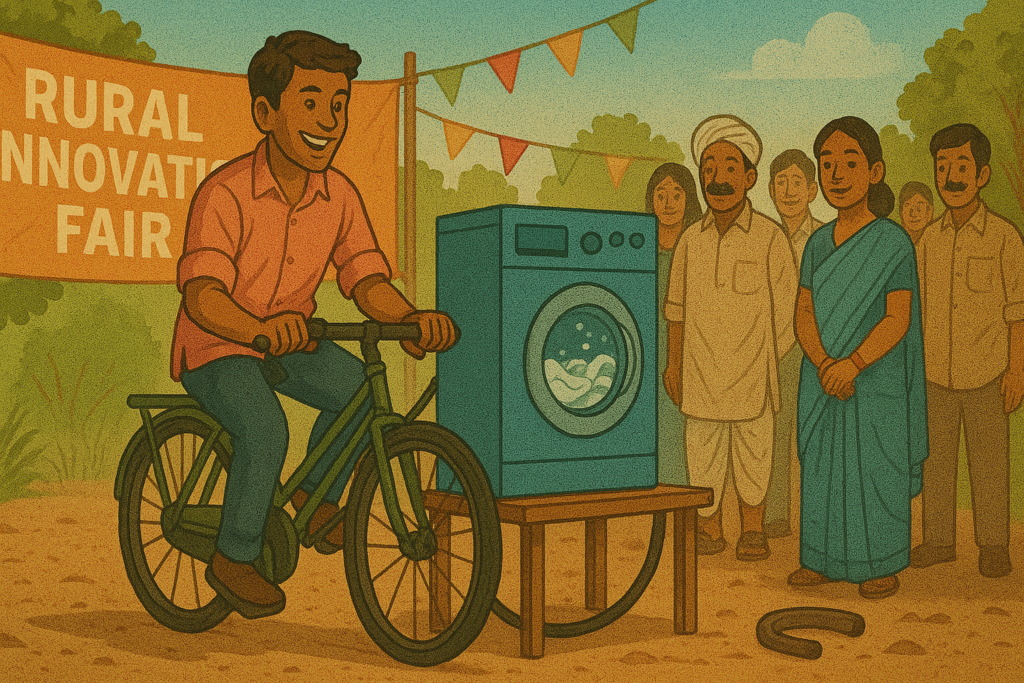Fun fact: In rural India, it’s not uncommon to see a diesel water pump mounted on a wooden cart transformed into a makeshift vehicle called a “jugaad gaadi” — a brilliant example of Indian ingenuity meeting necessity.
Introduction: What Is ‘Jugaad’ and Why It Matters
India is a land of contrasts — skyscrapers rising above slums, billion-dollar startups in the same cities where blackouts are routine, and digital wallets used next to cash-only chai stalls. But if there’s one thing that ties this chaotic harmony together, it’s a word that every Indian knows deeply: jugaad.
Jugaad is more than a word; it’s a way of life. It’s the art of bending limited resources to create maximum impact — a frugal, flexible, and often unorthodox problem-solving strategy born out of scarcity. In the Indian context, jugaad represents the creative genius of people who may not have access to state-of-the-art labs, fat budgets, or Ivy League degrees — but they have something arguably more powerful: resourcefulness.
But here’s the provocative part: Has jugaad become both a symbol of innovation and a barrier to systematic progress? Is India stuck in a loop of clever hacks, or is it finally transitioning from jugaad to structured, scalable innovation?
Jugaad: The Engine of Everyday India
Before India was known for its tech startups and Mars missions, we were a nation of self-taught engineers — farmers rigging irrigation systems, shopkeepers rewiring old fans, and families converting scooters into three-wheelers to ferry children to school.
Examples abound:
MittiCool Refrigerator: A clay fridge created by Mansukhbhai Prajapati that works without electricity, cooling through evaporation. It’s affordable, sustainable, and entirely made in India.
Plastic Bottle Irrigation: Farmers in drought-hit areas reuse plastic bottles to create drip irrigation systems, conserving water and increasing crop yield.
Cycle-powered Washing Machines: Students from rural colleges have built washing machines powered by pedalling, aimed at off-grid households.
These aren’t corporate-backed, patent-heavy innovations. They’re born from constraints — a textbook definition of frugal innovation.

When Jugaad Meets the Mainstream: Scaling Indian Ingenuity
The turning point comes when grassroots jugaad inspires formal innovation. Enter India’s innovation ecosystem — from government incubators to tech startups — trying to scale the best ideas that begin in backyards and bylanes.
Let’s look at a few success stories:
SELCO India
A social enterprise that provides solar-powered solutions to underserved communities. SELCO was born from the idea that energy access should not wait for grid expansion. Their modular solar kits power homes, schools, and even small businesses in rural India.
Company Description: SELCO India is a renewable energy enterprise that provides customised solar energy solutions to underserved and low-income communities.
Tata Nano: A Lesson in Affordable Engineering
Touted as the world’s cheapest car, the Tata Nano was a formal response to informal jugaads like attaching engines to auto rickshaws. Though its commercial journey was mixed, it inspired the global market to rethink frugal design.
Company Description: Tata Motors is an Indian automotive manufacturer that produces passenger cars, trucks, vans, and buses.
Jaipur Foot: Empowering Through Prosthetics
The Jaipur Foot, created by Dr. P.K. Sethi and Ram Chander Sharma, is a low-cost, durable prosthetic leg that has helped over 1.8 million people walk again.
Organization Description: Bhagwan Mahaveer Viklang Sahayata Samiti (BMVSS), the NGO behind the Jaipur Foot, provides free prosthetics to people with disabilities.
These examples prove one thing: when the spirit of jugaad is paired with design thinking, scalability, and institutional support, India produces world-class innovations.
The Double-Edged Sword: Limitations of Jugaad
Here’s where the debate gets complicated.
While jugaad is admirable, it often solves problems temporarily and may lack safety, durability, or efficiency. For instance:
- A hacked battery charger may overheat and explode.
- Makeshift vehicles are rarely road-safe.
- Workarounds in industries may bypass regulations, risking lives.
Excessive dependence on jugaad can hinder sustained investments in research and development (R&D), infrastructure growth, and robust quality assurance. The country risks becoming a land of brilliant patches rather than robust solutions.
From Jugaad to Structured Innovation: A Paradigm Shift
To truly progress, India must retain the creative essence of jugaad while building mechanisms to convert ideas into institutionalised innovation.
Here’s what needs to happen:
Education That Encourages Experimentation
India’s rote-learning system doesn’t foster problem-solving. Initiatives like Atal Tinkering Labs are changing this by giving school children tools to build prototypes, tinker, and think like inventors.
Funding and Incubation
Initiatives such as Startup India and Make in India are helping emerging entrepreneurs by offering financial assistance, mentorship, and greater visibility. But accessibility remains limited. Rural innovators still lack support in navigating patents, marketing, and scaling.
Bridging the Informal and Formal
Grassroots innovations need formal validation. Organisations like the National Innovation Foundation (NIF) are playing a vital role by scouting rural ideas and helping turn them into viable products.
Organization Description: The National Innovation Foundation (NIF), an independent institution under the Department of Science and Technology (DST), Government of India, promotes grassroots innovations by offering research support and funding opportunities.
Private Sector Partnerships
Tech companies and universities must actively seek out and fund grassroots prototypes. For example, Marico Innovation Foundation has helped scale solutions from sanitation to health tech that originated as low-budget jugaads.
Company Description: Marico Innovation Foundation is the CSR arm of Marico Ltd, focused on enabling scalable social innovations in India.
Global Recognition: India’s Frugal Innovation Model
Interestingly, what was once seen as “cheap improvisation” is now admired globally. Harvard Business Review has documented India’s frugal innovation as a model for developing nations. The West is now learning from India’s ability to “do more with less.”
Even companies like General Electric (GE) took a page from India’s book when it developed a portable, $800 ultrasound machine, inspired by Indian constraints.
Company Description: General Electric is a multinational conglomerate that produces healthcare, aviation, power, and renewable energy products.
Conclusion: The Future of Innovation Is Indian — If We Let It Be
India doesn’t lack intelligence, creativity, or ambition. It only needs better systems to capture that spirit, nurture it, and scale it.
We must stop romanticising jugaad as the end-all and start treating it as the beginning of the innovation journey. It’s time to invest in structures that channel creativity into solutions that are safe, scalable, and globally competitive.
The next billion-dollar idea may not come from a Silicon Valley garage but from a dusty workshop in Bihar, a school in Chhattisgarh, or a tribal village in Odisha. But it’ll only shine if we know how to take it from jugaad to innovation.
Author’s Note
As someone who has seen firsthand how Indian households, farmers, students, and workers innovate daily to beat the odds, this blog is a tribute to that incredible resilience. But it’s also a wake-up call — that real progress begins when we stop applauding clever hacks and start supporting thoughtful, inclusive innovation.
G.C., Ecosociosphere contributor.





Comments
Such a helpful article, thanks for posting! I’m definitely going to share this with my friends. I’m bookmarking this for future reference. I enjoyed reading this and learned something new. Thanks for taking the time to put this together!